|
Displaying items by tag: Quilts
The Metropolitan Museum of Art announced Monday that it had received a major gift of 20th-century works by African-American artists from the South, including 10 pieces by Thornton Dial and 20 important quilts made by the Gee’s Bend quilters of Alabama.
The works, 57 in all, are being donated by the Souls Grown Deep Foundation, which was begun in 2010 by the scholar and collector William S. Arnett to raise the profile of art by self-taught African-Americans. Thomas P. Campbell, the Met’s director, described the gift, which also includes work by Lonnie Holley, Nellie Mae Rowe and Joe Minter, as a significant enlargement of the museum’s holdings of work by black American artists.
The 2014 New Orleans Antiques Forum, “Southern Expression,” will explore the many facets of regional style with acclaimed experts in the field of decorative arts. This year’s topics include furniture, pottery, mourning jewelry and art, southern landscape paintings, clocks, quilts, and more.
The Historic New Orleans Collection established the New Orleans Antiques Forum (NOAF) in 2008 in an effort to boost cultural tourism in New Orleans and south Louisiana following Hurricane Katrina. Centered on a series of educational and entertaining talks, the three-day forum encourages the appreciation of decorative arts created in and imported through the Gulf Coast. Sessions are accessible to experienced collectors as well as beginning antiques enthusiasts.
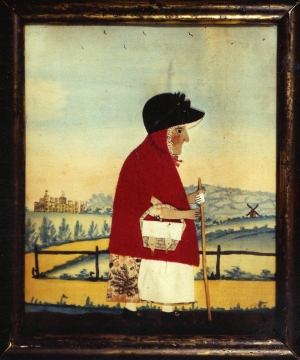
In this country, we don’t really go in for folk art – or at least, not in the way America does. Yes, there’s a collection of folk art on display at Compton Verney and another at the American Museum in Bath, but mostly it’s shown in local and regional museums. There’s nothing here on the scale or importance of the 150,000 works of art in the Shelburne Museum in Vermont or the American Folk Art Museum in New York City.
British condescension towards the whole subject was encapsulated in Jeremy Deller’s and Alan Kane’s insufferably smug installation Folk Archive, a personal collection of objects that served to illustrate for a metropolitan elite what the common folk like to do in their spare time. Had these two conceptual artists not made the blindingly obvious point that that the paraphernalia of Morris dancing and effigies of the Pope and Guy Fawkes reflect something or other about the nation’s collective unconscious, such folk artefacts would never have been allowed to pollute the sacred grove of high culture that is Tate Britain.
At first glance, this exhibition might seem a bit quaint, its subject — textiles and the Civil War — evoking Americana more than American history. But this show, “Homefront & Battlefield: Quilts and Context in the Civil War,” which opened last month at the New-York Historical Society after originating at the American Textile History Museum in Lowell, Mass., does much more: It turns Americana back into history.
The show traces its thematic threads through that period’s fabric with such care that, after seeing the patterns, you will not easily look at coarse woven cloth, the American flag, quilts, mourning clothes — or perhaps even the Civil War — in quite the same way again. Textiles, we come to see, did not just reflect the war’s events or were just another element of the conflict; in many ways they were at the war’s heart.
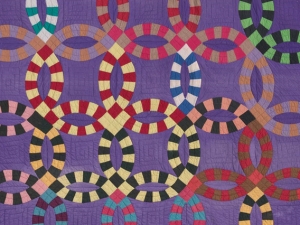
On April 6, Boston’s Museum of Fine Arts will present the exhibition ‘Quilts and Color: The Pilgrim/Roy Collection.’ The show will feature 60 quilts from the renowned Pilgrim/Roy collection, which was assembled by two trained artists, Paul Pilgrim and Gerald Roy, over five decades. Pilgrim and Roy favored bold and striking designs that echoed the work of mid-20th century Abstract Expressionists and optical artists.
The exhibition’s opening sections will begin with the brightly colored works that first caught the collectors’ attention and sparked their life-long passion for quilts. This portion will explore the principles of color theory and the use of color vibrations, mixtures, gradations and harmonies in quilts from the 19th to early 20th century. The exhibition will also touch on traditional designs, the effect of color and pattern, and artists who worked outside of standard patterns and design.
‘Quilts and Color: The Pilgrim/Roy Collection’ will be complemented by a number of events at the Museum of Fine Arts including discussions led by collector Gerald Roy and a live quilt making demonstration.
The exhibition will remain on view through July 27.
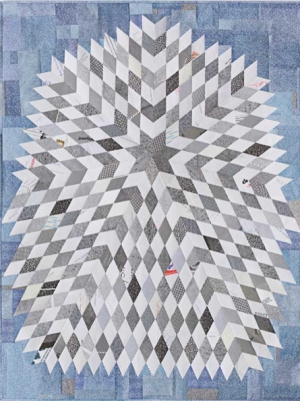
The American Folk Art Museum in New York presents the exhibition alt_quilts: Sabrina Gschwandtner, Luke Haynes, Stephen Sollins, which will feature works by three contemporary artists who are inspired by the history, meanings, and structures of American quilts. alt_quilts includes 23 contemporary works alongside 10 masterpiece quilts from the Folk Art Museum’s illustrious holdings.
Quilts were prominent large-scale artworks through the 19th century and remained a popular form of artistic expression for women until the 20th century. Dr. Anne Radice, Director of the Folk Art Museum, said, “Since its inception the American Folk Art Museum has celebrated a distinctly American phenomenon – the pieced quilt…the boundaries between artistic disciplines are even more blurred, and the contemporary works of art on view in this exhibition are especially illuminating.”
alt_quilts: Sabrina Gschwandtner, Luke Haynes, Stephen Sollins will be on view at the American Folk Art Museum through January 5, 2014.

On Sunday, August 18, 2013, the Shelburne Museum in Shelburne, VT will unveil its new Pizzagalli Center for Art and Education. To commemorate the event, the Shelburne Museum will offer free admission and host a celebration throughout the institution’s campus. Festivities will kick off at 11AM with a ribbon cutting ceremony.
The Pizzagalli Center, which was designed by the Boston-based architecture firm, Ann Beha Architects, boasts 18,000-square-feet and will allow the Shelburne Museum to expand their exhibition offerings as well as implement new programming. The Center is part of the $14 million capital campaign “The Campaign for Shelburne Museum,” which includes an endowment to maintain the center.
Founded by pioneering American folk art collector Electra Havemeyer Webb in 1947, the Shelburne Museum holds one of the most remarkable and diverse collections of art and Americana. The museum’s 150,000 holdings include Impressionist paintings, folk art, quilts, textiles, decorative arts, furniture, American paintings, and various artifacts dating from the 17th to 20th century, which are exhibited in 39 different buildings. Webb collected various 18th and 19th century structures including houses, barns, a lighthouse, a jail, and a steamboat to house her collection; 25 of the buildings are historic.
Traditionally a seasonal museum, the Shelburne will stay open year-round after the Center’s inauguration for the first time in the institution’s 66-year history.
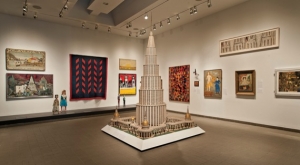
The American Folk Art Museum in New York received a $1.6 million grant from the Henry Luce Foundation that will help fund a major traveling exhibition of works from its collection. Since moving to a smaller location in 2011, the Folk Art Museum has only been able to display a portion of its collection. The traveling exhibition will allow for a more comprehensive experience.
The Henry Luce Foundation grant will enable Self-Taught Genius: Treasures from the American Folk Art Museum to visit 5 American cities over the course of 3 years. It will go on view at the American Folk Art Museum from May 13-August 17, 2014 before embarking on its journey. The show will feature over 100 works including quilts, paintings, drawings and sculptures.
Henry R. Luce, the co-founder and editor-in-chief of Time Inc., established the Luce Foundation in 1936. One of the Foundation’s missions is to strengthen international understanding and foster innovation in a variety of arenas including the arts. Since its founding, the Luce Foundation has given grants totaling over $145 million to approximately 250 institutions through its American Art Program.

On August 18, 2013 the Shelburne Museum in Shelburne, VT will open its new Center for Art and Education. Historically a seasonal museum, the Shelburne will stay open year-round after the Center’s inauguration for the first time in the institution’s 66-year history.
The Center for Art and Education, which was designed by the Boston-based architecture firm, Ann Beha Architects, boasts 18,000-square-feet and will allow the Shelburne Museum to expand their exhibition offerings as well as implement new programming. The Center is part of the $14 million capital campaign “The Campaign for Shelburne Museum.” The campaign includes an endowment to maintain the center as well as the installation of a fiber-optic communications network throughout the Shelburne’s site, which spans 45 acres.
Founded by pioneering American folk art collector Electra Havemeyer Webb (1888-1960) in 1947, the Shelburne Museum holds one of the most remarkable and diverse collections of art and Americana. The museum’s 150,000 holdings include Impressionist paintings, folk art, quilts, textiles, decorative arts, furniture, American paintings, and various artifacts dating from the 17th to 20th century, which are exhibited in 39 different buildings. Webb collected various 18th and 19th century structures including houses, barns, a lighthouse, a jail, and a steamboat to house her collection; 25 of the buildings are historic.
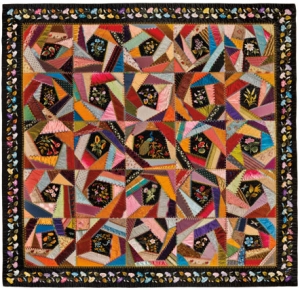
The Brooklyn Museum, which holds a celebrated decorative arts collection, is currently presenting a selection of rarely seen American and European quilts. In fact, only one of the 30-plus quilts on display has been on public view in the past 30 years.
The exhibition titled Workt by Hand: Hidden Labor and Historical Quilts aims to explore the impact of feminist scholarship on the ways in which historical quilts have been and are currently viewed, contextualized, and interpreted. The exhibition goes beyond the connection of quilting to feminism and explores the medium of quilting as an art form and as an aspect of material culture with meaningful social and political undertones.
The quilts on view at the Brooklyn Museum span two centuries and feature iconic designs and techniques including the log cabin style, the Amish sunshine and shadow style, and crazy quilts, which were fashionable during the late 19th century. A quilt by Mary A. Stinson that is considered one of finest examples of a crazy quilt is included in Workt by Hand.
Workt by Hand aims to shed light on the skill, craftsmanship, thought, and energy that went into quilting; something that was frequently overlooked in a male-dominated society. The exhibition, which is on view through September 15, 2013, includes photographs, newspaper clippings, sample pieces of quilts, and other ephemera relating to the history of quilts.
|
|
|
|
|